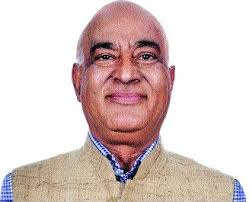Synchronised elections, voter behaviour, and governance outcomes
An active policy proposal of the Government of India is to hold national elections at the same time as the assembly elections of all the states. This article examines whether holding national and stat...
-
 Vimal Balasubramaniam
Vimal Balasubramaniam  Sabyasachi Das
Sabyasachi Das  Apurav Yash Bhatiya
Apurav Yash Bhatiya  28 August, 2020
28 August, 2020
- Articles
Political determinants of newspaper markets in India
Newspapers are an important source of political information for Indian voters. This article looks at how political factors influence the newspaper market. Using the announcement of delimitation in the...
-
 Julia Cagé
Julia Cagé  Guilhem Cassan
Guilhem Cassan  Francesca R. Jensenius
Francesca R. Jensenius  23 November, 2023
23 November, 2023
- Articles
A proposal for public funding of elections and political parties in India
The Finance Minister of India recently introduced measures aimed at cleaning up political party funding in the country. In this article, Gowda and Santhosh highlight the limitations of these measures,...
-
 M.V. Rajeev Gowda
M.V. Rajeev Gowda  Varun Santhosh
Varun Santhosh  21 April, 2017
21 April, 2017
- Perspectives
Reshaping social protection in India
As India has undergone a transformation in recent decades in terms of trends such as poverty reduction, food security and urbanisation, there is a need to also revamp the traditional social protection...
-
 Ejaz Ghani
Ejaz Ghani  12 April, 2024
12 April, 2024
- Perspectives
What explains policy change? Understanding the historical political economy of India
Drawing on insights from his new book, ‘History of Economic Policy in India’, Rahul De frames policy change as precipitating through three circumstances: crisis, coalitions, and contingency. He us...
-
 Rahul De
Rahul De  05 January, 2024
05 January, 2024
- Perspectives
Political determinants of newspaper markets in India
Newspapers are an important source of political information for Indian voters. This article looks at how political factors influence the newspaper market. Using the announcement of delimitation in the...
-
 Julia Cagé
Julia Cagé  Guilhem Cassan
Guilhem Cassan  Francesca R. Jensenius
Francesca R. Jensenius  23 November, 2023
23 November, 2023
- Articles
The growing wave of decentralisation: Comparative evidence from developing countries
Over the last few decades, decentralisation has been rapidly spreading in developing countries across the world, with around 35 countries announcing new or deepening decentralisation reforms in recent...
-
 Jean-Paul Faguet
Jean-Paul Faguet  Lakshmi Iyer
Lakshmi Iyer  Sarmistha Pal
Sarmistha Pal  16 November, 2023
16 November, 2023
- Videos
The growing wave of decentralisation: Comparative evidence from developing countries
Over the last few decades, decentralisation has been rapidly spreading in developing countries across the world, with around 35 countries announcing new or deepening decentralisation reforms in recent...
-
 Jean-Paul Faguet
Jean-Paul Faguet  Lakshmi Iyer
Lakshmi Iyer  Sarmistha Pal
Sarmistha Pal  16 November, 2023
16 November, 2023
- Podcasts
How Prayagraj is leveraging wastewater surveillance to prevent another pandemic
This note by Agrawal and Siva outlines efforts taken by the Prayagraj district in Uttar Pradesh to collect samples from sewage treatment plants and test them for the SARS-CoV-2 pathogen. They found a ...
-
 Sarthak Agrawal
Sarthak Agrawal  Dr. Archana Bharadwaj Siva
Dr. Archana Bharadwaj Siva  31 October, 2023
31 October, 2023
- Notes from the Field
Mainstreaming millets right: Dangers of promoting ultra-processed products
In the fifth post of the e-Symposium on ‘Carrying forward the promise of International Year of Millets’, Reshma Roshania argues that instead of relying on the ‘Big Food’ industry to increase t...
-
 Reshma Roshania
Reshma Roshania  20 October, 2023
20 October, 2023
- Perspectives
Impact of fiscal decentralisation and ethnic heterogeneity on choice of local polity
In this article, based on Chapter 7 of 'Decentralised Governance’, Mitra and Pal utilise Indonesia’s fiscal decentralisation to local communities in 2001 to examine how FD may differentially affec...
-
 Anirban Mitra
Anirban Mitra  Sarmistha Pal
Sarmistha Pal  13 October, 2023
13 October, 2023
- Articles
Decentralised targeting of transfer programmes: A reassessment
Ahead of the release of ‘Decentralised Governance: Crafting Effective Democracies Around the World’, Dilip Mookherjee brings together some of the arguments against decentralisation of welfare prog...
-
 Dilip Mookherjee
Dilip Mookherjee  25 September, 2023
25 September, 2023
- Perspectives
Forest Rights Act: An account of contradictory conservation laws
In the second of two articles about the implementation of Forest Rights Act, Bharti Nandwani uses data on land conflicts to investigate why land disputes increased after the introduction of FRA. She p...
-
 Bharti Nandwani
Bharti Nandwani  22 September, 2023
22 September, 2023
- Articles
Forest Rights Act: Political participation of indigenous communities
In the first of two articles about the implementation of Forest Rights Act, Bharti Nandwani looks at the implication of increased demand for land title recognition on political participation of Schedu...
-
 Bharti Nandwani
Bharti Nandwani  20 September, 2023
20 September, 2023
- Articles
Making the case for a common land registry
The lack of comprehensive data on India’s common lands affects conservation, resource use and land right conflicts. Chandran & Singh highlight the need for a national common land registry to reduce ...
-
 Pooja Chandran
Pooja Chandran  Subrata Singh
Subrata Singh  31 August, 2023
31 August, 2023
- Notes from the Field
Twitter feed
Tweets by Ideas4IndiaMost Popular Governance Posts
Unique Health Identification and Aadhaar: A case for mandatory linkage
As part of the Digital India initiative, All India Institute of Medical Sciences (AIIMS) issues a Unique Health Identification (UHID) number to each patient, which documents their entire journey in th...
 Mudit Kapoor
Mudit Kapoor  23 December, 2016
23 December, 2016
- Perspectives
Caste dominance in rural India: Cause and effect
Rural India remains a caste-based society. This column explores why caste continues to play such an important role and what the effects are. It argues that trade and agricultural productivity suffer, ...
 Siwan Anderson
Siwan Anderson  16 August, 2012
16 August, 2012
- Articles
Why did the Indian economy stagnate under the colonial rule?
How did the Indian economy fare under the colonial rule? Is the average Indian significantly better off after Independence? This column examines trends in GDP per capita in order to determine the stan...
 Aniruddha Bagchi
Aniruddha Bagchi  16 September, 2013
16 September, 2013
- Articles





 16 November, 2023
16 November, 2023






